The photographs presented here may be freely used for any non-commercial purpose, but please credit the photographers. For commercial use, please contact the photographers directly.
 |
St Helena Ebony (Trochetiopsis ebenus) is a Critically Endangered shrub found only on Saint Helena. The species declined sharply in the 18th century, mainly due to overgrazing by goats, and was once thought to be extinct. In 1980, two shrubs were rediscovered on the Island. All existing material in cultivation is derived from two individuals. This species was previously burned in limekilns to produce mortar. The wood was also used in the 19th century for turnery and ornament making and was introduced to British gardens around 1800. Photo © Rebecca Cairns-Wicks . |
 |
Black-browed Albatross (Thalassarche melanophrys) moved from Vulnerable in 2001 to Endangered in 2003. All 21 species of albatross are now identified as globally under threat (compared to just three in 1996 and 16 in 2000). All are undergoing long-term declines, with significant numbers drowning after being caught accidentally on baited hooks set by longline fisheries. BirdLife International’s "Save the Albatross” campaign is trying to reduce the accidental bycatch of seabirds by encouraging longline fisheries to adopt appropriate mitigation measures. Photo © Tony Palliser. |
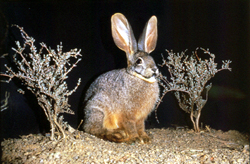 |
Riverine Rabbit (Bunolagus monticularis) is assessed as Critically Endangered. The species is found only in the central Karoo region of South Africa and the current population is estimated to be fewer than 250 breeding pairs. With ongoing habitat loss and fragmentation, and direct threats from trapping, feral cats and dogs, and hunting pressure, the population decline is not expected to stop in the near future. Photo © Andrew G. Duthie . |
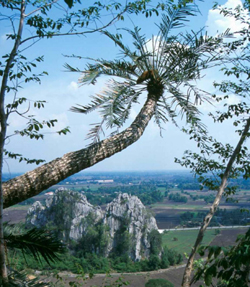 |
Cycas tansachana is a Critically Endangered, arborescent (treelike) cycad known only from limestone outcrops near Saraburi, Thailand. The plant is apparently quite restricted in occurrence and under severe pressure from plant collectors and limestone mining operations in the area. Photo © John S. Donaldson . |
 |
Centropogon erythraeus is assessed as Endangered based on its restricted range and decline. This shrub is endemic to Ecuador where it is known from two subpopulations in the southern Andes. The species is locally abundant in the Loja-Zamora road on the southern border in the Parque Nacional Podocarpus where it forms part of the pioneer vegetation on the roadsides. Photo © Suzanna León-Yánez . |
 |
Boreal Felt Lichen (Erioderma pedicellatum) is Critically Endangered. Over the last century, the boreal felt lichen has completely disappeared from New Brunswick (Canada), Norway and Sweden. The only remaining populations are in Canada where populations have suffered a major decline (more than 95% of the population in Nova Scotia has been lost). The population in Newfoundland is under permanent observation. Major threats to this species are habitat destruction through logging and air pollution. The decline, considered irreversible, of the global population is more than 80%. Photo © Christoph Scheidegger. |
 |
Mekong Giant Catfish (Pangasianodon gigas) is Critically Endangered. This species is one of the world's largest freshwater fish, found only in the lower Mekong River Basin. The population has declined by more than 80% over the last 13 years, mainly through over-exploitation and habitat loss and degradation. Increasing siltation of the river through past deforestation practices and obstruction of migratory routes through the construction of dams in the region may also have a negative impact on fish abundance in the river. Photo © Zeb S. Hogan. |
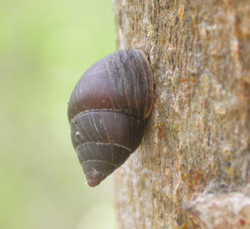 |
Bulimulus ochsneri is one of the many threatened terrestrial snails from the Galapagos Islands. Listed as Critically Endangered, Bulimulus ochsneri is endemic to Santa Cruz. The range of suitable habitat for land snails on Santa Cruz Island has declined because of human activities (farming, road and house construction, etc.) and destruction or alteration by introduced species. Photo © Christine Parent . |
 |
Uhiuhi (Caesalpinia kavaiensis). Listed as Critically Endangered, Caesalpinia kavaiensis is a forest tree found only on the islands of Hawaii and O’ahu. Only 60 individuals are known, however, many of these are old and probably non-reproductive. Threats include pigs, cattle, deer, goats, introduced plants, rats, fire, volcanic eruptions, sheep, black twig borer and collection by humans. Photo © Vickie L. Caraway . |
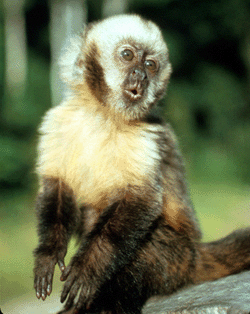 |
Yellow-breasted Capuchin (Cebus xanthosternos) is a Critically Endangered Neotropical monkey found in Brazil’s Atlantic Forest region. It has a very restricted and highly fragmented range. The species is also heavily hunted as bushmeat and for use as pets Photo © Russell Mittermeier. |
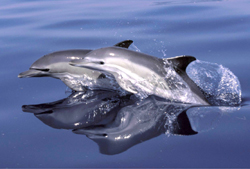 |
Short-beaked Common Dolphin (Delphinus delphis). Although the global population is still considered to be Least Concern, the Mediterranean subpopulation of Delphinus delphis has declined by more than 50% over the last 30-45 years and is assessed as Endangered. There has been a reduction in the availability of dolphin prey in the Mediterranean through a combination of environmental changes, overfishing and habitat degradation. Competition with fisheries and bycatch directly threaten the subpopulation, while high levels of polychlorinated biphenyls (PCBs) in Mediterranean dolphins, compared to levels in dolphins from other areas, may cause immune suppression and reproductive impairment. Photo © Giovanni Bearzi. |
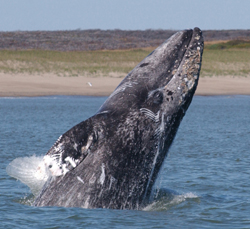 |
Gray Whale (Eschrichtius robustus). The Northwest Pacific (Asia) gray whale stock is assessed as Critically Endangered on the basis that it is geographically distinct, and is thought to have less than 50 reproductive individuals. This subpopulation was hunted to near extinction and remains severely depleted. The potential impacts of industrial activity throughout the subpopulation’s known range are poorly understood. Globally, the species is still Lower Risk/conservation dependent. Photo © David W. Weller. |
 |
Wood’s Cycad (Encephalartos woodii) is Extinct in the Wild. Only a single plant of this species was ever found. Its extinction may have been a natural event, although the final end of the wild population may have been hastened by over-exploitation for medicinal purposes by local people. In 1916 the last remaining stem was removed for cultivation in botanical gardens. There is no likelihood of ever reintroducing the species back into the wild as there are only male plants in existence, and the risk of theft would be too great. Photo © John S. Donaldson. |
 |
Maui Hesperomannia (Hesperomannia arbuscula), listed as Critically Endangered, is a small shrubby tree known only from the Hawaiian Islands of Maui and Oahu. There has been an observed population decline of 25-50% over the last three years and the number of known individuals is less than 25. Main threats to the species are habitat degradation by pigs, competition with alien plant species (prickly Florida blackberry, Christmas berry, Koster's curse and strawberry guava), predation by rats, and from trampling or collecting by humans. Photo © Vickie L. Caraway . |
 |
Golden Lion Tamarin (Leontopithecus rosalia) is endemic to Brazil. The species moved from Critically Endangered down to Endangered after nearly 30 years of conservation efforts resulted in a population increase. There are now estimated to be more than 1,000 individuals. There is little room for further expansion of the wild population, however, considering the extreme fragmentation and reduced forest cover within its range. Current and future conservation efforts are tackling this problem with reforestation and the establishment of habitat corridors. Photo © Juan Pratginestós/WWF-Brasil . |
 |
St Helena Olive (Nesiota elliptica) moved from Extinct in the Wild to Extinct in 2004. Endemic to Saint Helena, the last known surviving wild tree, on a steep cliff near Diana's Peak, died in 1994, and the only known plant in cultivation died in December 2003. No other live material (plants, seeds or tissues) remains in local or international collections. The extinction of this plant has been attributed to habitat loss through felling for timber and to make way for plantations. Photo © Rebecca Cairns-Wicks . |
 |
Pied Tamarin (Saguinus bicolor) is a Critically Endangered primate endemic to Brazil where it has a very restricted range. This species is probably not hunted for food, but it may be used as pets. The population is threatened by habitat loss, through urban growth, agriculture and cattle ranching in the vicinity of the capital of the state of Amazonas, Manaus. More importantly, the species is disappearing rapidly in areas of contact on the periphery of its range, where it is being replaced by the golden-handed tamarin (Saguinus midas ). Photo © Dominic Wormell. . |
 |
Pteris adscensionis is a fern, endemic to Ascension Island and assessed as Critically Endangered as a result of its highly restricted range. The population has been stable over the last five years but as it is known mostly from one location on the island it is extremely susceptible to extinction in the near future. Competition with introduced species is likely to have been responsible for past population decline. Photo © Tara George. |
 |
Cyanea superba is listed as Extinct in the Wild. This tree was endemic to the island of O'ahu in the Hawaiian Islands. Until recently, it was known to exist only in the Waianae mountains. More than 60 plants in two subpopulations were known in the 1970s, the species then declined to only five plants and these too have finally gone. The causes of the wild population’s extinction were competition with alien plants, habitat degradation by feral pigs, slugs and wildfire. Its restricted range also made the species extremely vulnerable to small local disturbances. Photo © Vickie L. Caraway. |
 |
Siphocampylus ecuadoriensis is an Endangered shrub. It is found only in Ecuador where it is known from nine subpopulations in the Andes. One subpopulation in the surroundings of the Papallacta-Cuyuja road faces a high risk of extinction, due to the ongoing conversion of native vegetation to pasture. Although the plant grows inside a protected area, deforestation still threatens the species. Photo © Suzanna León-Yánez . |
 |
Bennett’s Seaweed (Vanvoorstia bennettiana) was the first seaweed species to be listed on the IUCN Red List (in 2003); it is listed as Extinct. This Australian species has only ever been collected from two sites. No specimens have been seen or collected over the last 116 years, despite numerous collections made by algologists during that period. Habitat loss through human activities (trawling, dredging, infrastructure development, human settlement, tourism/recreation, water transportation, fisheries- related bycatch, and water pollution from agriculture, domestic, commercial/ industrial, oil, sedimentation and sewage) caused the extinction of this species. Photo © Alan J.K. Millar. |
 |
St Helena Boxwood (Mellissia begoniifolia) is a Critically Endangered shrub found only on Saint Helena Island. The wild population currently numbers 16. This population size fluctuates year by year, largely depending on weather conditions, but also on predation pressure. Currently only one plant in the population can be considered mature and it is from this that the majority of seed has been collected to establish plants in cultivation. Threats include attacks from aphids and caterpillars (Penelope worm), mice and rabbits. Growing in such a dry environment, the plants are also prone to drought. Photo © Rebecca Cairns-Wicks . |
The photographs presented here may be freely used for any non-commercial purpose, but please credit the photographers. For commercial use, please contact the photographers directly.
 |
St Helena Ebony (Trochetiopsis ebenus) is a Critically Endangered shrub found only on Saint Helena. The species declined sharply in the 18th century, mainly due to overgrazing by goats, and was once thought to be extinct. In 1980, two shrubs were rediscovered on the Island. All existing material in cultivation is derived from two individuals. This species was previously burned in limekilns to produce mortar. The wood was also used in the 19th century for turnery and ornament making and was introduced to British gardens around 1800. Photo © Rebecca Cairns-Wicks. |
 |
Black-browed Albatross (Thalassarche melanophrys) moved from Vulnerable in 2001 to Endangered in 2003. All 21 species of albatross are now identified as globally under threat (compared to just three in 1996 and 16 in 2000). All are undergoing long-term declines, with significant numbers drowning after being caught accidentally on baited hooks set by longline fisheries. BirdLife International’s "Save the Albatross” campaign is trying to reduce the accidental bycatch of seabirds by encouraging longline fisheries to adopt appropriate mitigation measures. Photo © Tony Palliser. |
 |
Riverine Rabbit (Bunolagus monticularis) is assessed as Critically Endangered. The species is found only in the central Karoo region of South Africa and the current population is estimated to be fewer than 250 breeding pairs. With ongoing habitat loss and fragmentation, and direct threats from trapping, feral cats and dogs, and hunting pressure, the population decline is not expected to stop in the near future. Photo © Andrew G. Duthie. |
 |
Cycas tansachana is a Critically Endangered, arborescent (treelike) cycad known only from limestone outcrops near Saraburi, Thailand. The plant is apparently quite restricted in occurrence and under severe pressure from plant collectors and limestone mining operations in the area. Photo © John S. Donaldson. |
 |
Centropogon erythraeus is assessed as Endangered based on its restricted range and decline. This shrub is endemic to Ecuador where it is known from two subpopulations in the southern Andes. The species is locally abundant in the Loja-Zamora road on the southern border in the Parque Nacional Podocarpus where it forms part of the pioneer vegetation on the roadsides. Photo © Suzanna León-Yánez. |
 |
Boreal Felt Lichen (Erioderma pedicellatum) is Critically Endangered. Over the last century, the boreal felt lichen has completely disappeared from New Brunswick (Canada), Norway and Sweden. The only remaining populations are in Canada where populations have suffered a major decline (more than 95% of the population in Nova Scotia has been lost). The population in Newfoundland is under permanent observation. Major threats to this species are habitat destruction through logging and air pollution. The decline, considered irreversible, of the global population is more than 80%. Photo © Christoph Scheidegger. |
 |
Mekong Giant Catfish (Pangasianodon gigas) is Critically Endangered. This species is one of the world's largest freshwater fish, found only in the lower Mekong River Basin. The population has declined by more than 80% over the last 13 years, mainly through over-exploitation and habitat loss and degradation. Increasing siltation of the river through past deforestation practices and obstruction of migratory routes through the construction of dams in the region may also have a negative impact on fish abundance in the river. Photo © Zeb S. Hogan. |
 |
Bulimulus ochsneri is one of the many threatened terrestrial snails from the Galapagos Islands. Listed as Critically Endangered, Bulimulus ochsneri is endemic to Santa Cruz. The range of suitable habitat for land snails on Santa Cruz Island has declined because of human activities (farming, road and house construction, etc.) and destruction or alteration by introduced species. Photo © Christine Parent. |
 |
Uhiuhi (Caesalpinia kavaiensis). Listed as Critically Endangered, Caesalpinia kavaiensis is a forest tree found only on the islands of Hawaii and O’ahu. Only 60 individuals are known, however, many of these are old and probably non-reproductive. Threats include pigs, cattle, deer, goats, introduced plants, rats, fire, volcanic eruptions, sheep, black twig borer and collection by humans. Photo © Vickie L. Caraway. |
 |
Yellow-breasted Capuchin (Cebus xanthosternos) is a Critically Endangered Neotropical monkey found in Brazil’s Atlantic Forest region. It has a very restricted and highly fragmented range. The species is also heavily hunted as bushmeat and for use as pets Photo © Russell Mittermeier. |
 |
Short-beaked Common Dolphin (Delphinus delphis). Although the global population is still considered to be Least Concern, the Mediterranean subpopulation of Delphinus delphis has declined by more than 50% over the last 30-45 years and is assessed as Endangered. There has been a reduction in the availability of dolphin prey in the Mediterranean through a combination of environmental changes, overfishing and habitat degradation. Competition with fisheries and bycatch directly threaten the subpopulation, while high levels of polychlorinated biphenyls (PCBs) in Mediterranean dolphins, compared to levels in dolphins from other areas, may cause immune suppression and reproductive impairment. Photo © Giovanni Bearzi. |
 |
Gray Whale (Eschrichtius robustus). The Northwest Pacific (Asia) gray whale stock is assessed as Critically Endangered on the basis that it is geographically distinct, and is thought to have less than 50 reproductive individuals. This subpopulation was hunted to near extinction and remains severely depleted. The potential impacts of industrial activity throughout the subpopulation’s known range are poorly understood. Globally, the species is still Lower Risk/conservation dependent. Photo © David W. Weller. |
 |
Wood’s Cycad (Encephalartos woodii) is Extinct in the Wild. Only a single plant of this species was ever found. Its extinction may have been a natural event, although the final end of the wild population may have been hastened by over-exploitation for medicinal purposes by local people. In 1916 the last remaining stem was removed for cultivation in botanical gardens. There is no likelihood of ever reintroducing the species back into the wild as there are only male plants in existence, and the risk of theft would be too great. Photo © John S. Donaldson. |
 |
Maui Hesperomannia (Hesperomannia arbuscula), listed as Critically Endangered, is a small shrubby tree known only from the Hawaiian Islands of Maui and Oahu. There has been an observed population decline of 25-50% over the last three years and the number of known individuals is less than 25. Main threats to the species are habitat degradation by pigs, competition with alien plant species (prickly Florida blackberry, Christmas berry, Koster's curse and strawberry guava), predation by rats, and from trampling or collecting by humans. Photo © Vickie L. Caraway. |
 |
Golden Lion Tamarin (Leontopithecus rosalia) is endemic to Brazil. The species moved from Critically Endangered down to Endangered after nearly 30 years of conservation efforts resulted in a population increase. There are now estimated to be more than 1,000 individuals. There is little room for further expansion of the wild population, however, considering the extreme fragmentation and reduced forest cover within its range. Current and future conservation efforts are tackling this problem with reforestation and the establishment of habitat corridors. Photo © Juan Pratginestós/WWF-Brasil. |
 |
St Helena Olive (Nesiota elliptica) moved from Extinct in the Wild to Extinct in 2004. Endemic to Saint Helena, the last known surviving wild tree, on a steep cliff near Diana's Peak, died in 1994, and the only known plant in cultivation died in December 2003. No other live material (plants, seeds or tissues) remains in local or international collections. The extinction of this plant has been attributed to habitat loss through felling for timber and to make way for plantations. Photo © Rebecca Cairns-Wicks. |
 |
Pied Tamarin (Saguinus bicolor) is a Critically Endangered primate endemic to Brazil where it has a very restricted range. This species is probably not hunted for food, but it may be used as pets. The population is threatened by habitat loss, through urban growth, agriculture and cattle ranching in the vicinity of the capital of the state of Amazonas, Manaus. More importantly, the species is disappearing rapidly in areas of contact on the periphery of its range, where it is being replaced by the golden-handed tamarin (Saguinus midas ). Photo © Dominic Wormell.. |
 |
Pteris adscensionis is a fern, endemic to Ascension Island and assessed as Critically Endangered as a result of its highly restricted range. The population has been stable over the last five years but as it is known mostly from one location on the island it is extremely susceptible to extinction in the near future. Competition with introduced species is likely to have been responsible for past population decline. Photo © Tara George. |
 |
Cyanea superba is listed as Extinct in the Wild. This tree was endemic to the island of O'ahu in the Hawaiian Islands. Until recently, it was known to exist only in the Waianae mountains. More than 60 plants in two subpopulations were known in the 1970s, the species then declined to only five plants and these too have finally gone. The causes of the wild population’s extinction were competition with alien plants, habitat degradation by feral pigs, slugs and wildfire. Its restricted range also made the species extremely vulnerable to small local disturbances. Photo © Vickie L. Caraway. |
 |
Siphocampylus ecuadoriensis is an Endangered shrub. It is found only in Ecuador where it is known from nine subpopulations in the Andes. One subpopulation in the surroundings of the Papallacta-Cuyuja road faces a high risk of extinction, due to the ongoing conversion of native vegetation to pasture. Although the plant grows inside a protected area, deforestation still threatens the species. Photo © Suzanna León-Yánez. |
 |
Bennett’s Seaweed (Vanvoorstia bennettiana) was the first seaweed species to be listed on the IUCN Red List (in 2003); it is listed as Extinct. This Australian species has only ever been collected from two sites. No specimens have been seen or collected over the last 116 years, despite numerous collections made by algologists during that period. Habitat loss through human activities (trawling, dredging, infrastructure development, human settlement, tourism/recreation, water transportation, fisheries- related bycatch, and water pollution from agriculture, domestic, commercial/ industrial, oil, sedimentation and sewage) caused the extinction of this species. Photo © Alan J.K. Millar. |
 |
St Helena Boxwood (Mellissia begoniifolia) is a Critically Endangered shrub found only on Saint Helena Island. The wild population currently numbers 16. This population size fluctuates year by year, largely depending on weather conditions, but also on predation pressure. Currently only one plant in the population can be considered mature and it is from this that the majority of seed has been collected to establish plants in cultivation. Threats include attacks from aphids and caterpillars (Penelope worm), mice and rabbits. Growing in such a dry environment, the plants are also prone to drought. Photo © Rebecca Cairns-Wicks. |